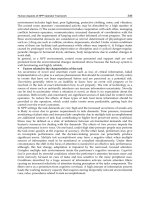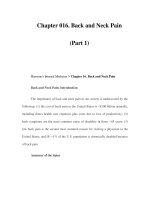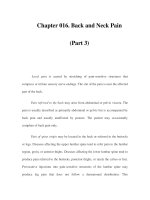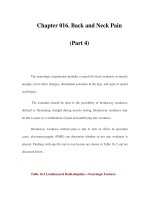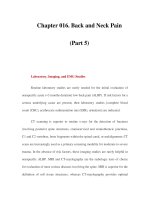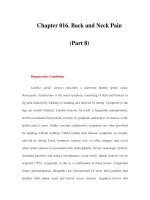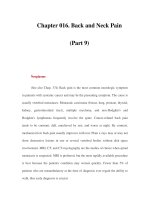Chapter 016. Back and Neck Pain (Part 13) pot
Bạn đang xem bản rút gọn của tài liệu. Xem và tải ngay bản đầy đủ của tài liệu tại đây (19.31 KB, 7 trang )
Chapter 016. Back and Neck Pain
(Part 13)
Chronic Low Back Pain
CLBP, defined as pain lasting >12 weeks, accounts for 50% of total back
pain costs. Risk factors include obesity, female gender, older age, prior history of
back pain, restricted spinal mobility, pain radiating into a leg, high levels of
psychological distress, poor self-rated health, minimal physical activity, smoking,
job dissatisfaction, and widespread pain. Combinations of these premorbid factors
have been used to predict which individuals with ALBP are likely to develop
CLBP. The initial approach to these patients is similar to that for ALBP.
Treatment of this heterogeneous group of patients is directed toward the
underlying cause when known; the ultimate goal is to restore function to the
maximum extent possible.
Many conditions that produce CLBP can be identified by a combination of
neuroimaging and electrophysiologic studies. Spine MRI and CT-myelography are
almost always the imaging techniques of choice. Imaging studies should be
performed only in circumstances when the results are likely to influence
management.
Injection studies can be used diagnostically to help determine the anatomic
source of back pain. Reproduction of the patient's typical pain with diskography
has been used as evidence that a specific disk is the pain generator. Pain relief
following a foraminal nerve root block or glucocorticoid injection into a facet has
been similarly used as evidence that the facet joint or nerve root is the source.
However, the possibility that the injection response was a placebo effect or due to
systemic absorption of the glucocorticoids is usually not considered. The value of
these procedures in the treatment of CLBP or in the selection of candidates for
surgery is largely unknown despite their widespread use. The value of
thermography in the assessment of radiculopathy also has not been rigorously
studied.
The diagnosis of nerve root injury is most secure when the history,
examination, results of imaging studies, and the EMG are concordant. The
correlation between CT and EMG for localization of nerve root injury is between
65 and 73%. Up to one-third of asymptomatic adults have a disk protrusion
detected by CT or MRI scans. Thus, surgical intervention based solely upon
radiologic findings increases the likelihood of an unsuccessful outcome.
An unblinded study in patients with chronic sciatica found that surgery
could hasten relief of symptoms by ~2 months; however, at 1 year there was no
advantage of surgery over conservative medical therapy, and nearly all patients
(95%) in both groups made a full recovery regardless of the treatment approach.
CLBP can be treated with a variety of conservative measures. Acute and
subacute exacerbations are managed with NSAIDs and comfort measures. There is
no good evidence to suggest that one NSAID is more effective than another. Bed
rest should not exceed 2 days. Activity tolerance is the primary goal, while pain
relief is secondary. Exercise programs can reverse atrophy in paraspinal muscles
and strengthen extensors of the trunk. Intensive physical exercise or "work
hardening" regimens (under the guidance of a physical therapist) have been
effective in returning some patients to work, improving walking distances, and
diminishing pain. The benefit can be sustained with home exercise regimens. It is
difficult to endorse one specific exercise or PT regimen given the heterogeneous
nature of this patient group. The role of manipulation, back school, or epidural
steroid injections in the treatment of CLBP is unproven. There is no strong
evidence to support the use of acupuncture or traction. A reduction in sick leave
days, long-term health care utilization, and pension expenditures may offset the
initial expense of multidisciplinary treatment programs. Studies of hydrotherapy
for CLBP have yielded mixed results; however, given its low risk and cost,
hydrotherapy can be considered as a treatment option. Transcutaneous electrical
nerve stimulation (TENS) has not been adequately studied in CLBP.
Pain in the Neck and Shoulder
Table 16-4 Cervical Radiculopathy—Neurologic Features
Examination Findings
Cervica
l Nerve Roots
Reflex
Sensor
y
Motor Pain
Distribution
C5 Biceps
Over
lateral deltoid
Supraspinatus
a
(initial arm
abduction)
Infraspinatus
a
(arm external
rotation)
Deltoid
a
(arm
abduction)
Biceps (arm
Lateral
arm, medial
scapula
flexion)
C6 Biceps
Thumb,
index fingers
Radial
hand/forearm
Biceps (arm
flexion)
Pronator teres
(internal forearm
rotation)
Lateral
forearm,
thumb, index
finger
C7 Tricep
s
Middle
fingers
Dors
um
forearm
Triceps
a
(arm
extension)
Wrist
extensors
a
Extensor
digitorum
a
(finger
extension)
Posterio
r arm, dorsal
forearm, lateral
hand
C8 Finger
flexors
Little
finger
Medial
Abductor
pollicis brevis
(abduction D1)
4th and
5th fingers,
medial forearm
hand and
forearm
First dorsal
interosseous
(abduction D2)
Abductor
digiti minimi
(abduction D5)
T1 Finger
flexors
Axilla
and medial
arm
Abductor
pollicis brevis
(abduction D1)
First dorsal
interosseous
(abduction D2)
Abductor
digiti minimi
(abduction D5)
Medial
arm, axilla
a
These muscles receive the majority of innervation from this root.
Neck pain, which usually arises from diseases of the cervical spine and soft
tissues of the neck, is common (4.6% of adults in one study). Neck pain arising
from the cervical spine is typically precipitated by movement and may be
accompanied by focal tenderness and limitation of motion. Pain arising from the
brachial plexus, shoulder, or peripheral nerves can be confused with cervical spine
disease, but the history and examination usually identify a more distal origin for
the pain. Cervical spine trauma, disk disease, or spondylosis may be asymptomatic
or painful and can produce a myelopathy, radiculopathy, or both. The nerve roots
most commonly affected are C7 and C6.
